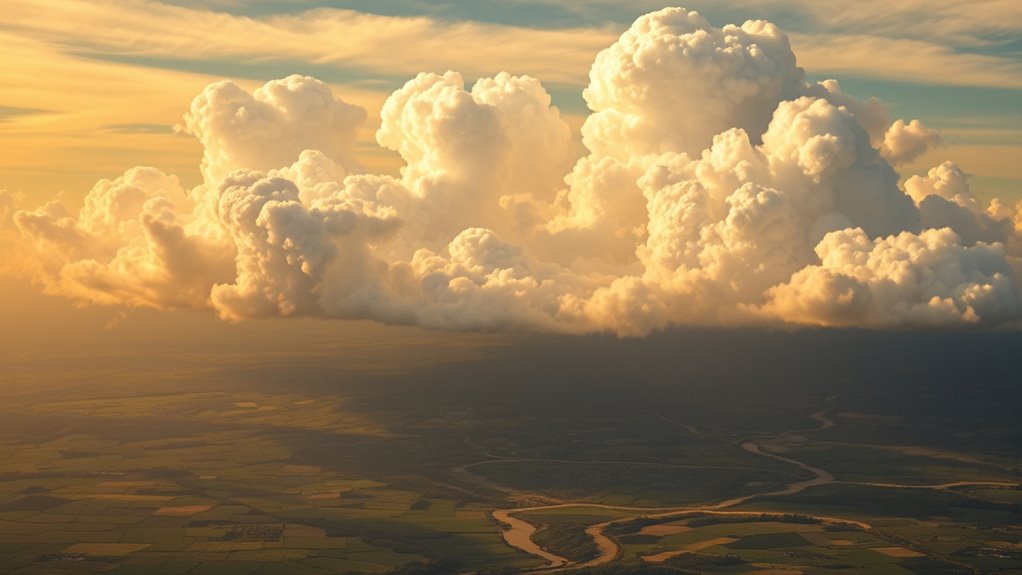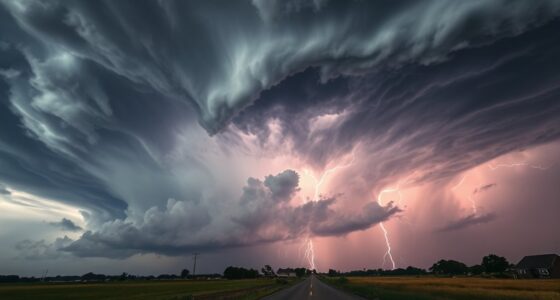The planetary boundary layer is essential because it influences how surface heating and terrain shape turbulence and thermals. These rising warm air currents help initiate cloud formation, especially cumulus clouds, by carrying moisture upward. The roughness of the terrain can strengthen or weaken these thermals, affecting weather patterns and local climate. To understand how these interactions drive weather development and cloud growth, continue exploring the fascinating dynamics of the boundary layer.
Key Takeaways
- The PBL’s turbulence fosters thermals that transport heat and moisture upward, essential for cumulus cloud formation.
- Surface heating causes buoyant air parcels to rise as thermals, initiating cloud development within the PBL.
- Terrain and surface properties influence turbulence intensity, affecting thermal strength and subsequent cumulus growth.
- Rising thermals within the PBL lift moist air, promoting cloud formation and influencing local weather patterns.
- Understanding PBL turbulence and thermals is vital for predicting cloud development and associated atmospheric processes.

The planetary boundary layer (PBL) is the lowest part of Earth’s atmosphere that directly interacts with the surface, playing a essential role in weather, climate, and air quality. As you observe the environment, you’ll notice that turbulence dynamics within this layer are constantly shaping how heat, moisture, and pollutants move. These turbulent motions aren’t random; they result from complex surface interactions involving surface heating, terrain, and roughness. When the sun warms the ground, it creates temperature differences that generate buoyant air parcels, leading to turbulent eddies. These eddies mix air vertically, influencing the development of thermals and, ultimately, cloud formation.
Understanding turbulence dynamics is key to grasping how the PBL influences thermals. As surface heating intensifies, warmer air rises in buoyant plumes called thermals. These thermals are essential because they transport heat and moisture upward from the surface into higher atmospheric layers. You’ll find that turbulence within the PBL fosters these thermals, creating a lively environment where warm air rises and cooler air sinks. This process not only impacts local weather but also determines how clouds, especially cumulus, grow. When thermals carry moist air upward, they can reach the level of free convection, where they cool and condense into cloud droplets, initiating cumulus development.
Turbulence fosters thermals that lift moist air, fueling cumulus cloud growth and influencing weather patterns.
Surface interactions play a critical role in this entire process. The nature of the terrain—whether urban, forested, or desert—affects how heat is absorbed and released, shaping turbulence patterns. For example, rougher surfaces enhance turbulence, leading to stronger thermals, while smoother surfaces produce less vigorous mixing. This variability influences how efficiently thermals form and ascend, directly impacting cloud growth. As thermals rise, they can trigger localized convection, which fosters the development of cumulus clouds. These clouds, in turn, modify surface interactions by shading the ground and altering local temperature and humidity conditions, creating a feedback loop.
In essence, by understanding the turbulence dynamics and surface interactions within the PBL, you get a clearer picture of how thermals initiate and grow into cumulus clouds. This process is fundamental to weather patterns and climate behavior, affecting everything from daily weather forecasts to long-term climate models. Recognizing the intricate dance between turbulence, surface conditions, and atmospheric responses helps you appreciate the complex yet fascinating processes occurring just above the Earth’s surface.
Frequently Asked Questions
How Does Pollution Affect the Planetary Boundary Layer?
Pollution, especially air pollution, thins the boundary layer and alters its dynamics. When you release pollutants into the boundary layer, they can trap heat and reduce turbulence, which affects thermals and cumulus growth. This change can lead to more stable conditions, suppressing cloud formation, or cause pollution to linger longer near the surface, impacting air quality and weather patterns. Your actions directly influence how pollution interacts with the boundary layer.
What Are the Main Factors Influencing Boundary Layer Height?
You might think only weather changes affect boundary layer height, but aerosol interactions and temperature gradients play bigger roles. When aerosols heat or cool the air, they alter temperature gradients, which directly influence how high the boundary layer can grow. These factors determine the turbulence, mixing, and stability of the layer, making them the main drivers behind boundary layer height variations. So, pay attention to how aerosols and temperature differences shape your local atmosphere.
How Do Boundary Layer Dynamics Vary Globally?
You’ll notice boundary layer variability across the globe, influenced by local factors like surface heating, terrain, and moisture. Global circulation patterns also play a key role, distributing heat and moisture unevenly. Over land, convection often causes a deeper boundary layer, while over oceans, it’s typically shallower. These dynamics create diverse boundary layer conditions worldwide, affecting cloud formation, weather, and climate in different regions.
Can Boundary Layer Processes Be Predicted Accurately?
You can predict boundary layer processes with reasonable accuracy by using turbulence modeling and boundary layer estimation techniques. These methods help you simulate how turbulence affects heat, moisture, and wind within the boundary layer. While models improve with better data and technology, some uncertainties remain due to the complex and dynamic nature of the boundary layer. Continuous advancements in modeling enhance your ability to forecast boundary layer behavior more precisely.
What Is the Impact of Climate Change on the Boundary Layer?
Climate change intensifies urban heat and alters aerosol effects, drastically impacting your boundary layer. As cities heat up, thermals become more vigorous, fueling more frequent and intense cumulus clouds. Increased aerosols from pollution can suppress or enhance cloud formation unpredictably, complicating weather patterns. You might notice hotter days, smoggier air, and more extreme weather events—showing how climate change reshapes the boundary layer, affecting your environment in profound ways.
Conclusion
By understanding the planetary boundary layer, you can better grasp how thermals and cumulus clouds develop, impacting weather patterns. Did you know that the boundary layer can be as shallow as a few hundred meters or stretch up to 2 kilometers on clear days? This variability plays a pivotal role in cloud formation and heat transfer. So, next time you see a cumulus cloud, remember it’s a sign of complex interactions happening right at Earth’s surface.









